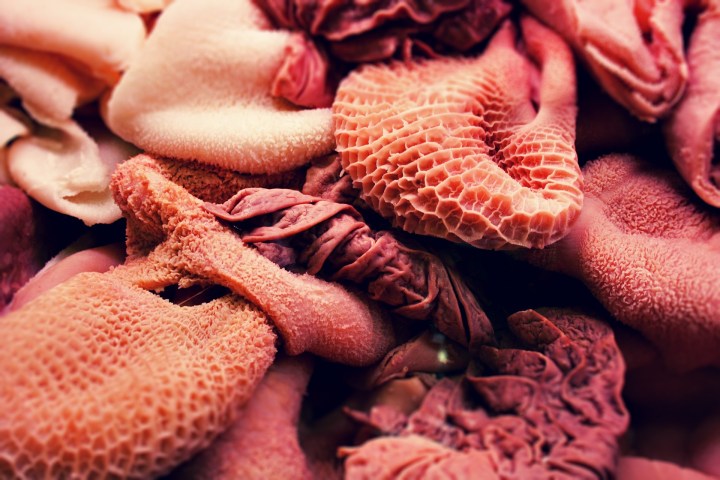KAROO KITCHEN
Fine fare from the Fifth Quarter

Offal has many names, most of them derogatory. Effluvium. Riffraff. Detritus. Chaff. Scraps. Pluck. Afval, debris, dregs, junk, refuse, trash, carrion. Yet it is the food of the poorest humans and of the fussiest palates.
Despite the slew of derogatory names for offal, there’s a better term, The Fifth Quarter, for the bits and pieces left behind once an animal’s carcass has been dissected and the supposed finer cuts sent to market.
In small town butcheries you will find the heads of pigs and sheep in display fridges along with the chops and wors; trotters, slow cooked, make a divine meal fit for the fussiest gourmet. Ditto beef cheeks and pork cheeks. Chicken feet are so sought-after by the poorest that they’re often dubbed walkie-talkies. Pig’s fat is used for enriching a lean venison stew. Kidneys are a tad more mainstream, as are livers, whether calf, ox, lamb or sheep, but even they have hordes of detractors.
When you live in a Karoo town, you know who lives on offal, or afval. The poor. The Sassa beneficiaries who queue for the pittance. Gardeners or itinerant labourers who stand on street corners hoping for work. Slave wages don’t go very far, and offal is cheap.
But the white Afrikaner community who populate the dorpies in the great swathes of the arid interior love their offal too. Kerrie afval is madly popular, tripe is beloved. Puzzled sympathy is poured on anyone who turns their nose up at skilpadjies (chopped liver in caul) or muise (smaller versions of the former).
But offal was a part of my Yorkshire background too. Though my parents had relocated to farflung Oranjemund, their palates travelled south with them. So steak and kidney puddings and pies, my dad’s adored tripe and onions, and the liver and onions that we all loved so much, were an ordinary part of our diet. I never did take to tripe, but my dad’s eyes misted up at the mere thought of it.
As a much older man I’ve developed a taste for other offal too. I’ve eaten brains, sweetbreads (pancreas) and the dreaded sheep’s testicles, and I have no qualms about eating the lining of a sheep’s stomach, which we call caul, or netvet.
But my favourite was and remains liver and onions. And this can be a very fine dish. In Britain, lamb’s or ox liver is more often used, and sometimes veal, but here in the Karoo we tend to favour sheep’s or lamb’s liver, being more abundant.
I have promised friends that I am going to get my head and tongue around kerrie afval (curried offal) one of these days, and I will deliver on that promise. I’ll even make it myself, and that I will share with you here.
In the meantime, I’ve been having a go at making old-fashioned liver and onions in the way that my parents’ generation brought with them, though it had been eaten at the Cape long before, in the days of the British colonists. My parents were latter day arrivals, in search of the sun after, in my dad’s case, a world war spent in the Royal Navy touring Asian ports from Bangkok and Hong Kong to Shanghai. He had to live in sunshine after all that.
Liver and onions cannot be claimed as a purely British dish, given that there are variations on it in many countries, from Italy (Venice in particular) to Germany, the USA, and Spanish and Portuguese variations travelled to South American nations and became part of their cultures too.
In every cuisine, and in every household, there will be variations, as is the way with almost all popular dishes in the world. Being a cook who likes to trust my own palate, I threw away all of the many recipes I had browsed over a few days, and wrote my own. There’s no point in slavishly following another cook’s recipe.
I decided on a few key ingredients. Liver and onions, for obvious reasons. But also white wine (I had contemplated red, but as a friend with a fine palate pointed out, “Wouldn’t white wine give it a more subtle character?” Always trust a fine palate. So white it would be.
I used bacon too, and this is a popular ingredient in many recipes for liver and onions. And I added just a hint of prepared mustard, because I felt that this would add something to the flavour profile, which it did. Mustard is not a common ingredient in it, however.
I felt it needed a herb too, but a subtle one, so thyme was added too, and a bay leaf.
But there was no cream. I chose instead to use the solid standby of reduction cooking, to create a sauce of deep and rewarding flavour. I was so happy with the result that I wished my mom and dad could have been there to share it with me. (Have a go at the recipe for my liver and onions.) DM/TGIFood
Follow Tony Jackman on Instagram @tony_jackman_cooks. Share your versions of his recipes with him on Instagram and he’ll see them and respond.
SUBSCRIBE to TGIFood here. Also visit the TGIFood platform, a repository of all of our food writing.



 Become an Insider
Become an Insider
Comments - Please login in order to comment.